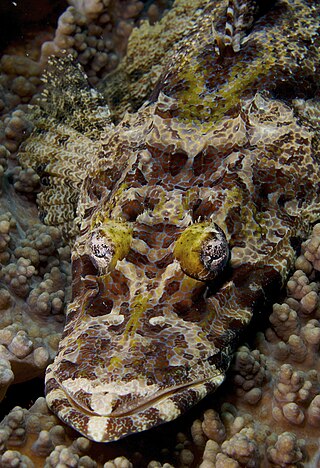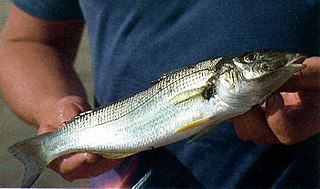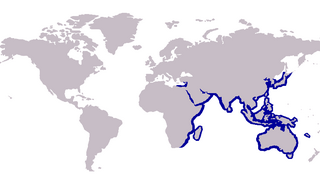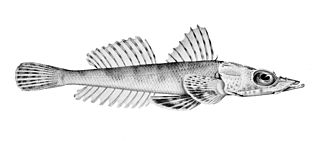
A flathead is one of a number of small to medium fish species with notably flat heads, distributed in membership across various genera of the family Platycephalidae. Many species are found in estuaries and the open ocean in the Indo-Pacific, especially most parts of Australia where they are popular sport and table fish. Flathead can grow at least 1 metre (3.3 ft) in length and 18 kilograms (40 lb) in weight, with dusky flathead being the biggest, although fish this size are seldom caught.

The Platycephalidae are a family of marine fish, most commonly referred to as flatheads. They are relatives of the popular lionfish, belonging to the order Scorpaeniformes.

Platycephalus is a genus of mostly marine, demersal ray-finned fish belonging to the family Platycephalidae. They are found in the eastern Mediterranean, the Indian Ocean and western Pacific Ocean.

Platycephalus fuscus, the dusky flathead or black flathead, is a large predatory fish and the largest member of the family Platycephalidae. Dusky flathead are a largely estuarine species and are found in estuaries, estuarine lakes and coastal bays on the east coast of Australia, from Cairns in Queensland to the Gippsland Lakes in Victoria. They occur over sand, mud, gravel and seagrass and can inhabit estuarine waters up to the tidal limit.

The tentacled flathead, also known as the Indian Ocean crocodilefish, Madagascar flathead or longhead flathead, is a species of marine ray-finned fish belonging to the family Platycephalidae, the flatheads. This species is in the western Indian Ocean, including the Red Sea and the Mediterranean, having invaded as a Lessepsian migrant through the Suez Canal. It is the only species in the monotypic genus Papilloculiceps.

De Beaufort's flathead, also known as the crocodilefish or giant flathead, is a species of marine ray-finned fish belonging to the family Platycephalidae, the flatheads. It is found in the Western Pacific Ocean.

The crossback stingaree or banded stingaree is a species of stingray in the family Urolophidae. It is endemic to southeastern Australia, mainly off Victoria and Tasmania but also marginally to New South Wales and South Australia. This bottom-dwelling fish generally inhabits sand and reef habitats deeper than 100 m (330 ft) off Victoria, and muddy habitats in shallow bays and estuaries off Tasmania. Befitting its name, the crossback stingaree has a distinctive dark pattern on its back, consisting of a midline stripe that is crossed by three transverse bars. It has an oval pectoral fin disc with a blunt snout and a skirt-shaped curtain of skin between the nostrils. Its tail is short with no skin fold along the sides, and a deep, leaf-shaped caudal fin. The youngest rays may have a small dorsal fin in front of the stinging tail spine. This species reaches 50 cm (20 in) in length.

The sand whiting, also known as the summer whiting, yellowfin whiting or blue-nose whiting, is a common species of coastal marine fish of the family Sillaginidae, the smelt-whitings. It is a slender, slightly compressed fish that is very similar to other species of Sillago, with detailed spine, ray and lateral line scale counts needed to distinguish the species between its nearest relative Sillago analis. The sand whiting is distributed along the east coast of Australia from Cape York south to Tasmania, as well as Lord Howe Island and New Caledonia in the Pacific Ocean.

The black bream, also commonly known as the southern black bream, southern bream and blue-nosed bream, is a species of anadromous ray-finned fish of the porgy family Sparidae. A deep-bodied fish, it is occasionally confused with other similar species that occur within its range, but is generally distinguished from these species by a lack of yellow ventral and anal fins. Southern black bream are endemic to the southern coasts of Australia from Shark Bay in Western Australia to Ulladulla, New South Wales, as well as Tasmania.

Smelt-whiting is the common name for various species of the family Sillaginidae. The Sillaginidae are distributed throughout the Indo-Pacific region, ranging from the west coast of Africa to Japan and Taiwan in the east, as well occupying as a number of small islands including New Caledonia in the Pacific Ocean. Well known members of this family include King George whiting, Japanese whiting, northern whiting, sand whiting and school whiting.

Porgy is the common name in Australia for any fish which belongs to the family Sparidae. They are also called bream. Porgies live in shallow temperate marine waters and are bottom-dwelling carnivores. Most species possess grinding, molar-like teeth. They are often good eating fish, particularly the gilt-head bream and the dentex.

The bartail flathead, also known as the Indian flathead, gobi or Indo-Pacific flathead, is a species of largely marine ray-finned fish belonging to the family Platycephalidae, the flatheads. This species is found in the Indian Ocean and the Western Pacific Ocean, and has invaded the eastern Mediterranean Sea.

Platycephalus speculator, the southern bluespotted flathead, Castelnau's flathead, deepwater flathead, king flathead, Lakes Entrance flathead, longnose flathead, shovelnose flathead, Southern dusky flathead, Southern flathead or yank flathead, is a common species of flathead. This species is endemic to southern Australia.

The belligerent sculpin, or flathead sculpin, is a species of marine ray-finned fish belonging to the family Cottidae, the typical sculpins. This species occurs in the northern Pacific Ocean.
The Guinea flathead is a species of marine ray-finned fish belonging to the family Platycephalidae, the flatheads. It is found in the eastern Atlantic Ocean along the western coast of Africa. This species is the only known member of the genus Solitas. It is also the only flathead species which has a natural distribution which lies outside of the Indo-Pacific.

Platycephalus laevigatus, the rock flathead, black flathead, grass flathead, king flathead, marbled-bellied flathead, Port Albert flathead, smooth flathead or Southern rock flathead, is a species of marine ray-finned fish belonging to the family Platycephalidae, the flatheads. This species is endemic to Australia.

Platycephalus caeruleopunctatus, the bluespotted flathead, drift flathead, Eastern blue-spot flathead, longnose flathead, red flathead, red spotted flathead, sand flathead or yank, is a species of predatory ray-finned fish belonging to the family Platycephalidae, the flatheads. Bluespotted flathead are a marine species and are predominantly found in offshore waters and coastal bays on the east coast of Australia where they are almost exclusively found on marine sand.

Platycephalus bassensis the Southern sand flathead, Bass flathead, bay flathead, common flathead, sand flathead, sandy, sandy flathead, slimy flathead or yanks, is a species of marine ray-finned fish belonging to the family Platycephalidae, the flatheads. It is endemic to Australia.
Inegocia japonica, the Japanese flathead, rusty flathead or smooth flathead, is a species of marine ray-finned fish belonging to the family Platycephalidae, the flatheads. It is found in the Indo-West Pacific region.

The tuberculated flathead is a species of marine ray-finned fish belonging to the family Platycephalidae, the flatheads. This species is found in Indian and Western Pacific Oceans.

















